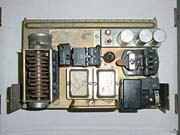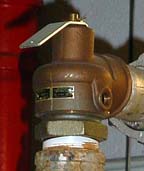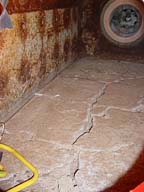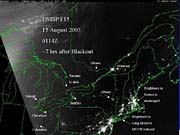Normal operations and then poof, all power gone. No warnings, everything just went dead. This was reality for nearly 50 million people and every associated plant with process combustion equipment like boilers, ovens, and furnaces.
Electrical power issues come in many forms but can have the same combustion system impact. They interrupt fan system airflow, the ability to ignite, and the ability to control combustion processes. In some cases, it could be a brownout and/or voltage sag that could take you out. In other cases it could be a momentary blip. Listed here are 12 combustion equipment/electrical power-related issues that must be taken into consideration when it comes to maintaining the integrity and safety of equipment. Whether or not you were impacted last August, pay attention and reevaluate your systems to make sure they are not taken off line in an unsafe manner and/or damaged if a blackout or power disruption happens in your area.

1. Burner management system failure issues.
Burner management systems (BMSs) can be destroyed from brownouts (voltage sags). Destroying a burner management system means that your equipment is not functional for a few hours if you have a spare and the unit you have is still supported by the manufacturer and not obsolete.If, however, yours is an older electro-mechanical style, you are vulnerable to being out of service for many days. Older style obsolete BMS systems must be upgraded when changed out. This often means a complete re-wire of your control panel and trying to find and order a new BMS in a crisis mode.
Review your BMS systems for obsolescence. The website www.combustionsafety.com contains a listing of BMS systems no longer supported by manufacturers. If you have one of these, consider upgrading it now. It's also a good time to make sure you have a spare BMS system lying around or that you have ready access to one. When you consider the potential for loss, a few thousand dollars for a spare BMS is a great investment.
2. Loss of cooling for fans, doors and bearings.
Cooling water is sometimes designed into oven doors and cooling bearings on fans. In some cases, forced draft and induced draft fans on boilers have water-cooled bearings, but sometimes this water flow is not alarmed, or the loss of this water flow is not alarmed. If this water were to be interrupted due to a city, municipal, or booster pump problem, it may spell major trouble. In some cases, plants recirculate water and have city water as a backup. In Cleveland, OH, during the recent blackout, even the city's backup water was not available. To avoid this situation, backup generators should have recirculated water pumps. Cooling water must have a backup system and/or some type of flow or temperature alarm. In addition, these alarms and backups should be tested regularly.
3. System failure modes can mean trouble.
It's important to know at what position each part of your combustion system is configured to fail in the case of a power interruption. For example, what position do damper linkages or boiler feed water valves end up in (fully open, at their last position, or fully closed)? The wrong position can be catastrophic. Control systems must be configured to make for a safe start-up after an unexpected equipment shut down.Another issue deals with equipment that may be able to restart automatically when power is restored. Some burner management systems do not provide a lockout circuit for key interlocks that require manual reset. This process requires a person physically pressing the reset button to restore operation. Without a manual reset feature, equipment can instantly restart without warning. This can be extremely dangerous after momentary outages and can damage some components.
Solid fuels in boilers can be an especially big problem when unexpected outages occur. A big pile of coal burning on a stoker grate takes time to burn itself out. If you don't keep water in the drums and/or air moving in, you can make a heck of a mess. This is why it's prudent practice to have bypass valves around boiler feedwater valves so that city water can be manually fed in case of an emergency. It's also a good idea to understand what happens if you lose one of your fans, and to plan an emergency shutdown procedure. If not, you could end up with smoke and ash throughout the boiler house.
4.Start-ups now can be more of a challenge.
Starting up is always a cause for concern. If you shut down instantaneously at high fire with no planning, you could have a firebox with enough fuel in it to be in the flammable range. All it would take is a hot ignition source for an explosion to occur. In some cases, you should consider trying to restart only after the firebox has had a chance to cool off. Remember your combustion basics: it's all about fuel, air and heat as an ignition source. If you were at high fire and lost power, it could have taken four seconds for the fuel valves to close and still have been operating within the timing required by most codes. This could put a lot of unburned fuel in the firebox. Waiting for the firebox to cool could minimize the risk of an explosion.
In some cases, adding purge air to a firebox that already contains fuel and a hot ignition source can create the right conditions for an explosion. Make sure that you have well-documented start-up/shutdown procedures that consider this circumstance as well as other pre-start walk down issues. Combustion Safety's website identifies other pre-start walk around safety issues that you should make a part of your site's culture.

5. Improper shutdowns can mean trouble (fans not cooled down).
Shutting down in a hurry means that, in some cases, large diameter oven fans won't get a chance to cool down as the manufacturer had intended. Many oven shutdown procedures call for ventilation and recirculation fans to continue to operate after flame failures and/or during orderly shutdowns to protect them from overheating and warping. If a forced shutdown with no time for cooling happens and you cannot do anything about it, be careful to listen for noises and vibrations during start-up. This could mean that you have destroyed fans, bearings or shafts during an outage. It could also mean that the equipment is no longer safe to operate in that condition. It is better to recognize fan damage and stop for an inspection than to start up with an imbalance and have the fan come apart.6. Do safety switches and interlocks work correctly?
When things do not operate correctly, we rely on safety controls such as high- and low-gas pressure switches, airflow switches, and flame detectors to keep us safe. When we experience power outages, systems are definitely not operating correctly. and we rely on this equipment to work.
Consider the case of airflow not being correct due to a loss of fan power or voltage during a brownout or a full blackout. In these cases, we must have properly functioning airflow switches to ensure that fuel valves do not remain open during these conditions. In addition, all other safety interlocks need to be tested at least annually by qualified personnel, and they have to work at the right set points and conditions. If you do not have a regular program for testing these devices you are inviting big problems.

7. Refractory damage vulnerability.
When you do bring systems back up, make sure you check for signs of failed refractory. Some equipment could be prone to refractory failures after an outage because the refractory brick is again thermally cycled. This is something you should be aware of during any start-up. Refractory failures usually are indicated by glowing hot spots on equipment, and/or burned paint or changed surface colors on the outside of equipment walls.8. PLC controller issues.
If you have PLC's (programmable logic controllers) you may be surprised by how things are configured during a post power loss start-up. Your system will most likely recover to whatever was recently stored in the EEPROM or non-volatile memory. Volatile memory relies on power to the equipment and would be lost during a shutdown. You must be aware of this and make sure that the post start-up configuration of your system is safe.
If you have PLC controls, now might be a good time to see that your backup memory storage batteries are in good working order. Functioning backup memory could be the difference between safety and a crisis.

9. Special atmospheres can mean trouble for heat treat ovens.
Remember that heat treat operations utilizing special combustible atmospheres are extremely vulnerable to power loss issues. In these cases, you must get the atmosphere out and safely burned off or a catastrophe can result. This means having inert gases like nitrogen available to push the atmosphere out in an orderly manner or having a manual burnout procedure in place. Make sure that all control systems are built and configured to get purging materials to the appropriate area even under power outage conditions.10. Intermediate products can be hazardous and costly.
Casting and smelting facilities also need to consider back-up power to get molten metal poured out and/or kept hot until it can be processed. Likewise, certain processes that generate flammable and/or flammable vapors must be able to evacuate the combustibles to facilitate an orderly and safe shutdown.11. Loss of boiler auxiliaries can mean trouble.
Many boiler facilities in the past were built with steam turbine auxiliaries. It was common to find boiler feedwater pumps, and even many forced and induced draft fans, running off of steam. Today, it's rare to see this in most industrial plants, and even major institutions.
If you absolutely must stay on line during power events, you may want to again revisit the possibility of having steam turbine drives for some of your auxiliary systems. Steam turbine drives are also something that can be used to balance steam loads and may even have an economic payback versus emergency generators.
12. Pressure surges and steam safety relief valves.
The sudden loss of power in a major manufacturing facility could mean that control valves for processes suddenly slam shut. This means that lots of steam is already in the system flowing towards the valve when there's suddenly no place to go. Steam is also something that does not instantaneously stop being generated. When this happens, safety relief valves pop open. If they don't pop open, things fly apart and people die. This means that now more than ever you must embark on a safety relief valve testing program. Safety relief valves need to be lift tested or otherwise verified to operate at least once a year. Make sure that if you've never tested, you seek out some guidance first. You can damage valves and get hurt if you do it wrong.So What's the Answer?
There is not one simple answer to this problem. It is dependent on your specific situation and needs. You can consider backup power generation for critical processes. Backup power is a wonderful thing and can never hurt. Also, remember that emergency generators require routine maintenance and exercise so that they can be reliable and effective when called into duty.However, be aware that there are many decisions to be made when you consider the back-up power generation and the form it takes. These decisions include which loads, what kind of fuel, what size engine, and even whether this should be continuous duty or stand-by rated. NFPA 110 (Life Safety Code) identifies two different classifications of generator systems--Level I and Level II. Each calls for significantly different design and maintenance criteria. Level I generators are considered life safety generators. They require items like fuel availability, even in the case that the facilities' main fuel is shut off during an emergency.
Another option for emergency power protection is to have a UPS or uninterrupted power supply for critical control systems. If you have a UPS for your control systems or back-up generation, you will have the ability to force your controls to certain positions and to do an orderly and safe shutdown. If not, you must be concerned with where each control goes when it suddenly fails due to loss of power.
UPSs are already common practice for most computer systems. It works the same way for boiler or combustion equipment controls. Critical controls can usually be run through the system at all times, such that when the power is out, there is no interruption of control system power at all.
In some systems, very important control systems are operated with compressed air. Compressed air has an advantage in that if you have it designed properly it can buy you time. This additional time can allow you to make a controlled shutdown while the air receiver that stores compressed air slowly drains down.
The blackout that plagued the East resulted in a lot of disruption. It was also somewhat of a regionalized event. Utility officials say that our nation's grid system is in shambles and that this could happen again. We live in a world where electrical grid outages and terrorist incidents are real. It is your responsibility to understand the impact to your facility and to act before it's too late.